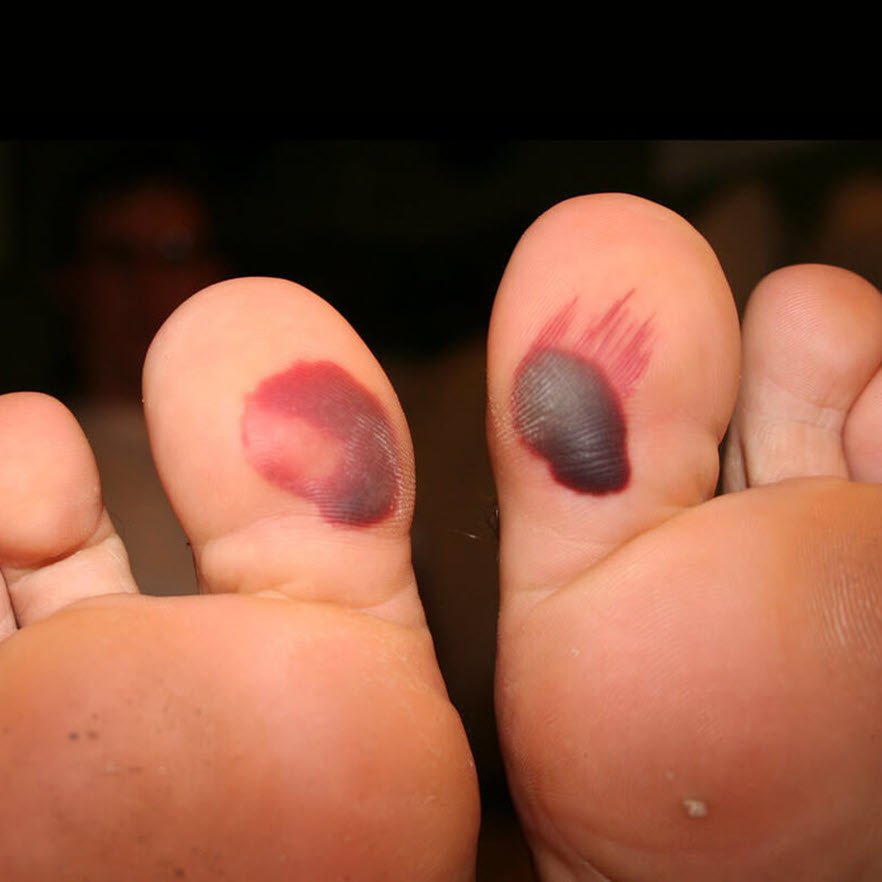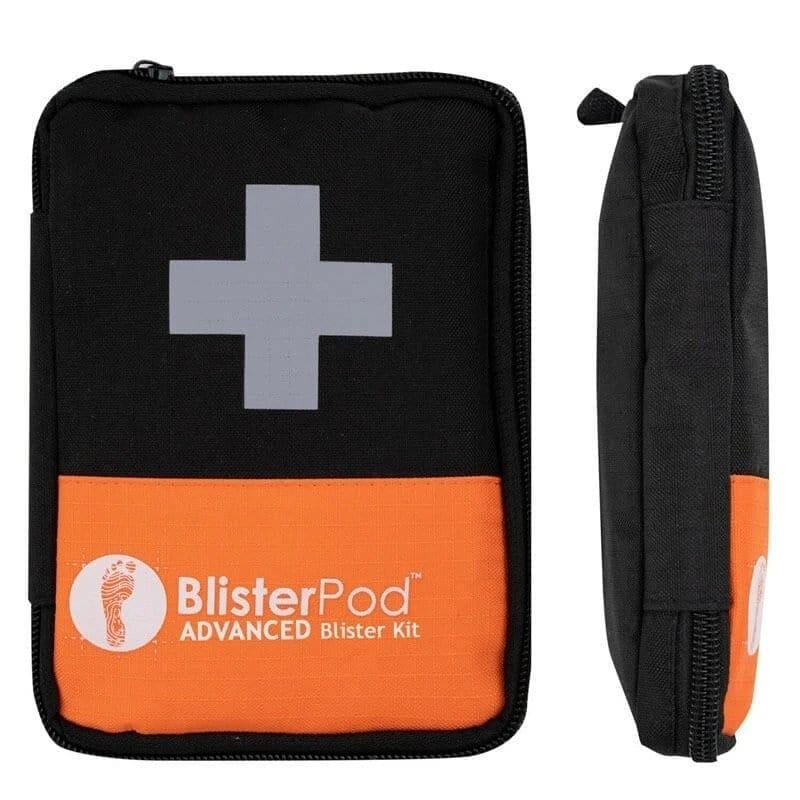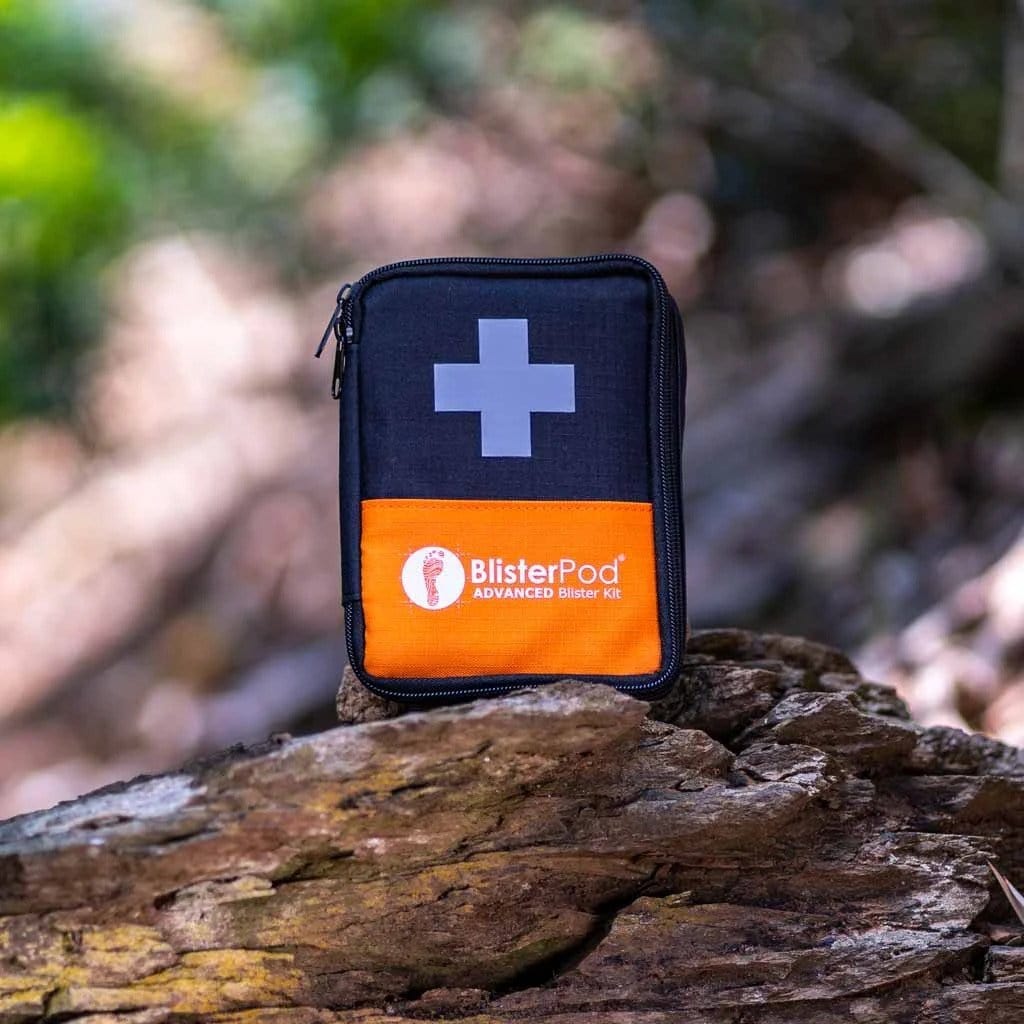UPDATED: Normal friction blisters are full of clear fluid. Blood blisters have blood mixed in with the normal blister fluid. They look red at first, and then go a darker purple/black colour as they dry. It pays to have a healthy respect for blood blisters on feet as they pose a heightened risk for infection.
Do you know why blood blisters form? How to deal with them? Do you pop them or not? And how long will they take to heal?
Summary
Blood Blister Do’s
- Do apply an antiseptic - just in case it pops
- Do protect it with a sterile island dressing - like a bandaid
- Do get the pressure off it (or at least reduce it) and reduce friction levels - otherwise it will get worse
Blood Blister Don'ts
- Don't just ignore it and keep going - it will very likely tear and open itself up to infection
- Don't ignore the benefits of popping it - but only if the situation is right! (more on that in a moment)
- Don't neglect pressure relief and friction relief - otherwise it will get worse
FAQs About Blood Blisters
1. What Can Cause Them?
The presence of blood in a blister indicates there is high pressure component. It's this high pressure that causes deeper injury compared to normal blisters. When there is injury to small blood vessels in the dermis, blood is able to leak into the epidermis and mixes with the normal blister fluid. That's why blood blisters often occur over joints and bony prominences: like the bony bit at the back of the heel, the toes and the metatarsal heads (ball of the foot).
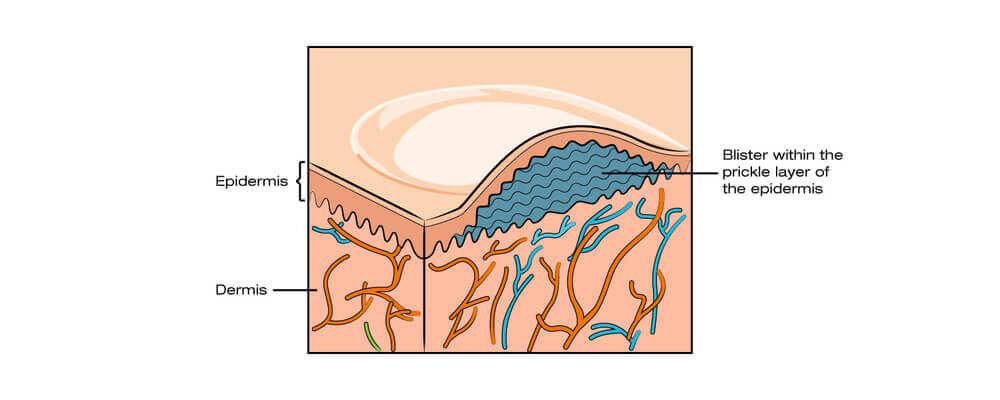
Blood vessels exist in the dermis, not the epidermis where blisters form. That’s why normal blisters are not filled with blood.
2. What Colour Are Blood Blisters Meant To Be?
In the initial stages, a blood blister looks red. Then as the blood dries and coagulates over time, is goes a purple or black. You can read more about the colours of blisters here
Caution: If you notice a black spot on your foot, be mindful there are other potential diagnoses other than a blood blister. Of highest importance would be melanoma. If there has been no trauma to have caused a blood blister, please consult your doctor to rule out melanoma.
3. How Long Do Blood Blisters on Feet Take to Disappear?
We know it takes somewhere from 30 to 48 days for full epidermal cell turnover - that is for cells to travel from their deepest to most superfical, to be shed as dead skin cells. It took 6 weeks in this case study. So that's how long it will take for the discolouration to disappear. The blood will dry relatively quickly, assuming you take away the cause (remember to reduce pressure and friction levels). If you don't deal with the cause, your blood blister will recur and the whole process will take longer.
As the damaged skin and dry blood works its way to the surface, you may find a lot of black dried blood that flakes away. Or there may be just a little - it will depend on these things:
- How big your blister was
- How much of the fluid was reabsorbed
- And how effectively you were able to deal with the cause
Blood Blister Causes
Structural Causes
Bony prominences are at most risk, like a bunion for example. Your forefoot is wider when you have a bunion. However, it's not necessarily the bunion protuberance itself at most risk of developing a blood blister. It's the weightbearing undersurface that's at risk. There's a concentration of pressure as the prominent joint bulges over the sole of the shoe. Coupled with high friction, there's a blood blister waiting to happen.
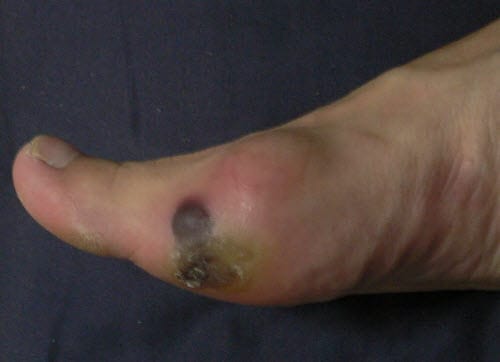
Edge Blood blister under a callous in the presence of a bunion (image credit: Sue’s Ramblings). You can read more about edge blisters here.
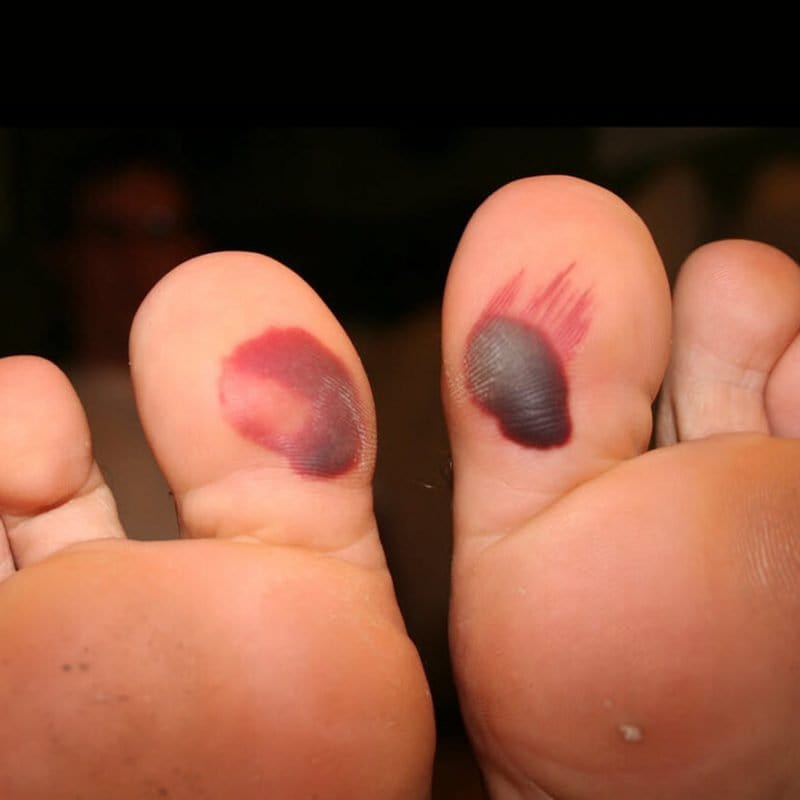
Blood blisters under big toes
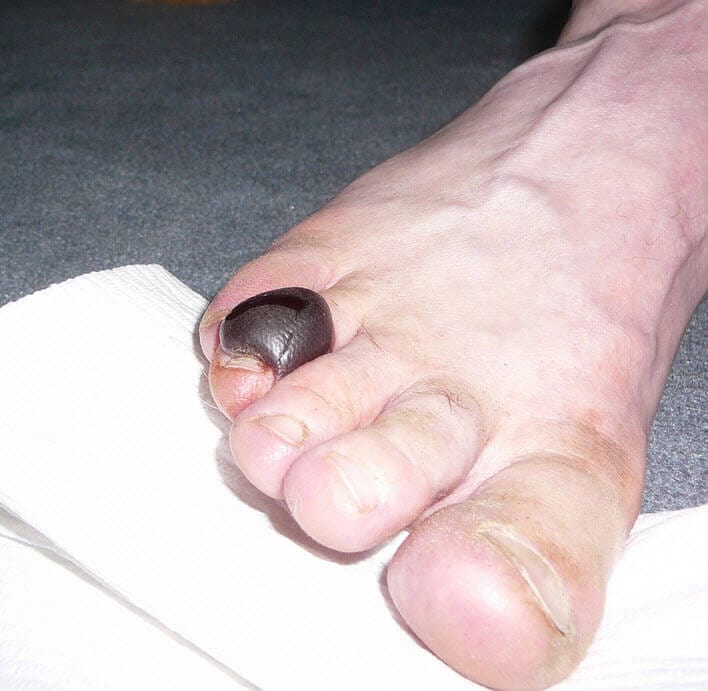
Toe blood blister
Biomechanical Causes
The blood blisters under the big toes in the first image of this article are a consequence of the foot's biomechanics. There's an important function of the 1st MPJ (big toe knuckle) called the windlass mechanism. When it's not working adequately, there can be extremely high pressure under the joint of the big toe - where these blisters are.
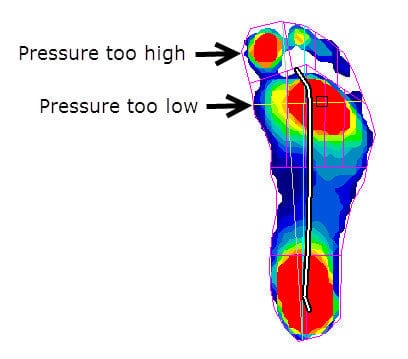
Functional hallux limitus (inefficient windlass mechanism) as a cause of blood blisters under the big toe.The best way to deal with this is with to see a Podiatrist because they know how to facilitate the windlass mechanism - treatment will likely include orthotics and calf stretches and maybe some other things, depending on where you're getting blood blisters.
Really, the best way to get on top of any recurring blood blister that you don't know the cause of, is to see a podiatrist. We know a lot about foot structure and functions and the best ways to reduce pressure points and friction levels.
What Do You Do With a Blood Blister On Your Foot?
If you miss the blister prevention boat and end up with a blood blister, follow the normal blister treatment sequence to get rid of that foot blisters. But now, preventing infection really is your priority! As a result, consider the options below, depending on your blister location, the environment you're in and what gear you have access to.
Blood Blister Treatment Should Include:
a) Take Away All Pressure
If it's possible, remove all pressure to ensure the blister roof remains intact and allow it to heal in its own time. For example, a blood blister on top of your toe would benefit from simply wearing open-toed sandals. Similarly, a blister at the back of your heel would get relief from wearing open-backed scuffs. However, if your blister is under your foot, or you simply must wear enclosed shoes, it's impossible to negate all pressure.
b) Reduce Some Pressure AND Reduce Friction Levels
This is where pressure deflection can help in conjunction with reducing friction levels on and around the blister. They are called friction blisters, after all! Here's How:
- Reduce pressure with donut pads cut from thick adhesive orthopedic felt. The idea is you place the cavity over your blood blister to keep the pressure off it.
- Reduce friction levels with Engo Blister Patches. You stick these to your shoe or insole to stop the skin stretching (shearing) and tearing the capillaries further.
Are You Supposed To Pop A Blood Blister On Your Foot, Or Not?
There are times when keeping the blister roof intact is not the best option. It can be better to take matters into your own hands rather than ignore it and simply hope for the best. If you have the right equipment, you could deal with this appropriately and safely. It sure beats putting your blood blister with roof intact back into your shoe with no dressing and no pressure relief, therefore just leaving it to chance.
However, please realise the risk of bacterial infection when you open up a blister. For the following few days, you'll need to be on the watch for signs of blister infection which include redness, swelling, pain and pus. Moreover, if you notice red streaks extending from your blister up your leg, this is serious and you need urgent medical attention.
Okay, so you've decided you want to lance your blood blister. Perhaps the amount of blood accumulating is causing pain; perhaps the blister is too big and likely to tear anyway; perhaps you have to carry on running or hiking and need this blister deflated. These are all legitimate reasons to pop a blood blister... but only if you have the right gear!
One more time, remember, it is okay to not lance your blood blister. In other words, if in doubt, don't pop it! Read this article to help you decide if to lance or leave alone, or watch the video below.
The Equipment You'll Need
If you are going to lance your blister, here's what you'll need to do it so it doesn't hurt and to avoid infection (below). This is a great little blister kit. We call it the Sterile Blister Lance Pack and we sell it from our online store. With expedited shipping, you could have one of these in your hands tomorrow so you can start looking after your blood blisters, infection-free. There are enough items in this pack to provide 4 blister lancing and treatment episodes.
Plus, I've included easy to follow instructions to help you every step of the way in lancing your blister safely and painlessly.
On a related note, if you’ve got a black toenail, here’s how to treat it by drilling the nail. You can use the hypodermic needles in the Sterile Blister Lance Pack to perform this procedure.
Blood Blister On Your Toe (Or Hand Or Finger)
Whether you've got a blood blister on your toe or your finger, the principles of treatment are the same. It's trickier on the feet though - not least of which is because we have to stand, walk and run on them. Our feet are subject to high weightbearing pressures and high contact pressures from footwear. As a result, these forces can undo any healing we are trying to facilitate with our treatment.
The other main difference between foot and finger blood blisters is our feet are generally a more germy environment, and so they're more susceptible to infection. Think about it... our feet keep us in contact with the ground, which is a germy environment. Then we cover them in socks and shoes and keep them out of sight. Think about the warm, humid and dark environment they live in!
Please note that I am a podiatrist. In other words, I provide information about friction blisters on the feet (not on legs, hands, the face or elsewhere).
When Should You See a Doctor?
In most cases, you won't have to see a doctor. As long as the blister roof stays intact, it is a sterile environment. All you need to do is remove the blister cause so it doesn't get bigger or burst. However, if your blood blister pops and gets bigger or more sore or red, it may be infected (check these signs of infection). See your doctor for medical advice specific to your situation if things are getting worse rather than better.
If you choose to lance it, now you now know what gear you'll need, how to perform the operation and how to look after it. Grab your Blister Lance Pack and do it safely and painlessly.
